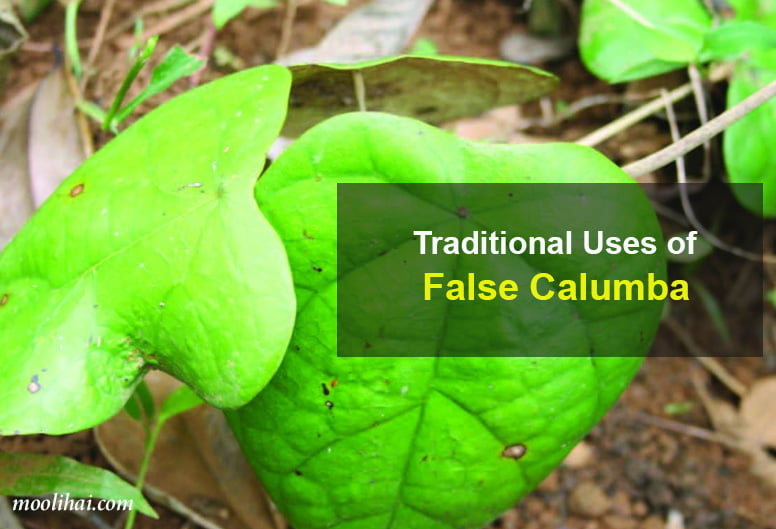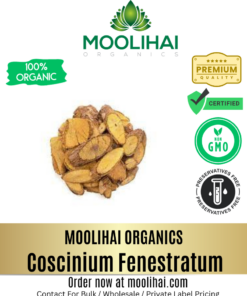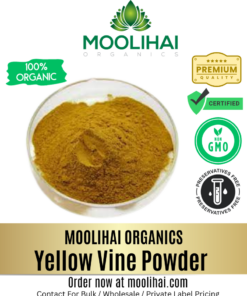Guide
Traditional Benefits and Side Effects of Coscinium Fenestratum (Mara Manjal)
Coscinium fenestratum is a medicinal herb that offers a lot of ayurvedic benefits, it is derived from the source medicine daruharidra. Every part of this herb produces innumerable uses, its stem is used as a yellow dye and bitter tonic.
Europeans named this plant as “tree turmeric or false calumba”, it comes under the Menispermaceae family. You can see the growth of this herb if the average annual temperature is 27°C and more than 2000 mm of rainfall. You’ve to wait for 15 years to attain countless benefits, it needs that much time for reproduction.
The species is used botanically to treat various ailments such as,
Skin diseases, ulcers, inflammation, jaundice, high blood pressure, snake bites, and diabetes.
Its habitat extends from India to Indonesia in parts of South Asia and Southeast Asia. It grows in tropical climates and but the growth will be very quick in dense evergreen forests with fertile soil and high humidity.
Common Names of Yellow Vine
- Botanical Name: Coscinium fenestratum
- Tamil Name: Manjal Kodi, Maramanjal, Pasamantram, Udaravi, Kadari, Atturam
- English Name: Tree turmeric, Columbo weed, False calumba
- Hindi Name: Dary Haldi
- Kannada Name: Maradashina, maramanjali
- Malayalam Name: Maramannal, maramanjal
- Telugu Name: Kasturi Pushpa
- Odiya Name: Daruharidra, Daruhaldi
- Punjabi Name: Daru haldi
- Marathi Name: Daruhalad
- Bengali Name: Daruharudra
- Gujrati Name: Daru Haldar
- Urdu Name: Darhald
Plant Description
- The botanical name of the yellow vine is Coscinium fenestratum which grows up to 3.5 ft, and it comes with yellow to brown color bark. The upper leaves are dark green while the lower leaves are light green.
- The flowers are yellow and hermaphrodite, the blooming season starts from April to May.
- The fruit color is violet, while the shape is ovoid, it is rich in vitamin C.
- The native of this plant is India, and it also has been reported in Vietnam.
- It grows well in the western ghats of Karnataka, such as Udupi, Coorg, Uttar Kannada, and Dakshin, in Kerala, Wynand, Idukki, Thiruvananthapuram, Palakkad, and Thrissur, in Tamilnadu Nilgiris, Tirunelveli, and Kanyakumari districts.



Medicinal Properties of Yellow Vine
| Rasa (Taste) | Tikta (Bitter), Kashaya (Astringent) |
|---|---|
| Guna (qualities) | Laghu (Light), Rooksha (Dryness) |
| Vipaka (Taste conversion after digestion) | Katu (pungent) |
| Veerya (Potency) | Ushna (Hot) |
| Effect on Tridosha | Balances Kapha and pitta Dosha |
| Dhatu (Tissue) | Plasma (Rasa), Blood (Rakta), Fat (Meda) |
| Srotas (Channel) | Excretory (Mutravaha, Purishavaha), Circulatory (Raktavaha), Digestive (Annavaha) |
Chemical Constituents of Coscinium Fenestratum
It includes alkaloids such as oxyberberine, berberine, oxyacanthine, aromoline, palmatine, berbamine, karachine.
Berberine is the primary constituents of the yellow vine; Rhizome can be found in stem bark. Berberine includes anti-trachoma, anti-inflammatory, antiprotozoal, antioxidant, antidiarrheal, antimicrobial properties. Flowers have polyphenols such as meratin, quercetin, caffeic acid, chlorogenic acid, and rutin.
Overview About Coscinium fenestratum ( Maramanjal )
Yellow vine is a deciduous evergreen shrub found in subtropical and temperate regions of Asia, the Americas, and Europe. The native of this plant is the Himalayas and wetlands of Sri Lanka in the regions of India and Nepal. It is also cultivated in India in Assam and Bihar.
Its fruits are juicy and rich in sugars and nutrients. Indigenous people often eat the fruits of Daruharidra as sweets. Water juice, roots, fruits, and stems proved clinical values.
This plant is an excellent source of dye and tannin, used in leather or dyeing fabrics.
Its roots are also used for manufacturing the liquor locally. The taste of this herb is bitter and astringent, easy to digest, intense, and has warm energy. It balances Kapha and pitta dosha in your body. Coscinium fenestratum’s medicinal benefits and qualities are very similar to turmeric.
Scientific Information About Tree Turmeric
| Kingdom | Plantae (Plants) |
|---|---|
| Phylum | Tracheophyta |
| Class | Magnoliopsida |
| Order | Ranunculales |
| Family | Menispermaceae |
| Genus | Coscinium Colebr |
Medicinal Benefits of Coscinium fenestratum or Maramanjal (Yellow Vine)
It comes with an excellent drying quality that heals wounds quickly and removes moisture. Its paste can be used externally to get rid of pain and swelling immediately. It is one of the most effective herbs to cure diabetes and urinary tract infections. Applying Daruharidra paste removes skin diseases and itching; it is used in herpes.
It can cure pain and itching disorders related to eyes, ears, and oral cavity. If you have menstruation, leukorrhea, and spasmodic pain in the abdomen, this yellow vine can give relief. It is used to treat diarrhea. The herb’s decoction can be used as eye-related problems, swelling, and inflammation caused by eye infections. Moreover, this decoction can increase voice quality and eliminates throat infections. Its paste is used to treat systolic ulcers and fistula.
Traditional Uses of Coscinium fenestratum

- It is one of the best Ayurvedic medicines,to cure diabetes.
- The decoction is given after baby birth, in Peninsular Malaysia.
- Apply Coscinium fenestratum and turmeric paste for snake bites. To do this, dilute the juice thirty times with water and wash the affected areas. Also, consume Rasad (1/8 tsp) in butter (1 tbsp).
- Stem juice or bark decoction is used to treat intermittent fever.
- The taste of the root is bitter; it is used as a tonic to soothe wounds and cure ulcers.
- Smash the roots to boil. Consuming it every day can cure abdominal pain and colitis.
- Bathing with the root water can give you relief from body pain.
- If you are affected by the burns, stomach disorders, skin diseases, fever, diabetes, and general weakness, this yellow vine herb is the best treatment. It has the ability to cure these ailments.
- Coscinium fenestratum is one of the best natural remedies for fractures.
- Take the bark and boil them with the water. Drink this decoction every morning on an empty stomach. You can feel the difference.
- If you want to treat leucorrhoea and gynecological harassment, you can use the bark of this herb.
- It is very beneficial to treat eye diseases and influenza.
- The plant has been linked to other medicinal plants to treat herpes, in coastal Karnataka, India.
- It can control excessive bleeding while menstruating.
- Use ghee with coscinium powder mix, to cure ulcers quickly.
- Traditional healers have used the bark of this herb for treatment, in Chhattisgarh.
- Take the root powder and decoction, consume it to cure flatulence, indigestion, fever, and liver diseases.
- As its roots are hepatoprotective in nature; thus, it can fight liver toxicity. Moreover, it will give an excellent result for jaundice.
- Its fruit is an appetizer, thus stimulating the digestive function treats diarrhea.
- In case of constipation and piles problems make use of this herb.
How to Use Coscinium fenestratum
1. Yellow Vine Churna
Take 1/2 tsp of yellow vine churna, add some honey or milk. Consume it after 1 hour of meals.
2. Coscinium fenestratum Powder
Take 1 tsp of false calumba powder, add some rose water into it. Make a paste and apply directly on the affected area for up to 4 hours. Use this treatment once a day; it can heal your burns faster.
3. Maramanjal Capsule
Consume milk with one or two mara manjal capsules after lunch and dinner.
4. Daruharidra Kwath
Take 1/2 tsp of yellow vine powder. Add 2 cups of water and boil them until it reduces into 1/2 cup. Strain and take 4 tsp of it. Consume them before meals once a day.
5. To Cure Remittent Fevers
Take 5 grams of Coscinium fenestratum roots, 5 grams of dried giloy, and some basil leaves, boil them with 400 ml of water. Drink this decoction less than a quarter of the water twice a day. Consume it for some days; you can feel the better change. It can cure chronic fever for any reason. It also effectively works on liver function.
Also Read: Natural Herbs to Cure Fever
6. For Piles (Bawasir), Ulcerative Colitis, Duodenal Ulcer, Infection in the Intestine
Take 5 grams of Coscinium fenestratum roots, boil them with 400 ml of water. Consume this decoction twice a day. It gives better improvement for all types of piles. You can use the Rashad for piles treatment. To do this, dilute the juice thirty times with water and wash the affected areas. Also, consume Rasad (1/8 tsp) in butter (1 tbsp).
7. To Treat Diabetes
Consuming anti-diabetes medicine with a specific product, such as turmeric extract and milk thistle extract can reduce the blood sugar levels in diabetics. It is not clear whether these benefits are caused by false calumba, milk thistle, or a mixture.
Also Read: Herbs for Diabetes
8. For High Cholesterol
Consuming Coscinium fenestratum extract with milk thistle juice can help reduce cholesterol levels when taken alone or with high fat medications. It may help people who cannot tolerate high doses of drugs known as statins. It is not clear whether these benefits are caused by false calumba, milk thistle, or a mixture.
Also Read: Herbs & Spices To Lower Cholesterol
9. For Swollen Eyes
Take 5 g of coarse powder of Coscinium fenestratum, soak them in 100 ml of water overnight. Boil them until they come in half amounts. Filter it at room temperature to irrigate the swollen eye.
10. Conjunctivitis
Take the filtered decoction of 2 ml with honey. Drop 1 to 2 drops in the affected eye at regular intervals 4 to 6 times a day.
Interaction
Cyclosporine (Neoral, Sandimmune) interacts with Coscinium fenestratum
The body breaks it down cyclosporine (Neoral, Sandimmune). Coscinium fenestratum may reduce how quickly the body breaks down cyclosporine (Neoral, Sandimmune). It can lead to the presence of excess cyclosporine (Neoral, Sandimmune) in the body and cause side effects.
Liver-modified drugs (Cytochrome P450 3A4 (CYP3A4) substrates) interacts with Coscinium fenestratum
Some drugs are converted and broken down by the liver. Coscinium fenestratum may reduce how quickly the liver breaks down certain drugs. Combined false calumba with some medications that break down the liver can improve some medicines’ side effects and side effects.
If you are taking liver-modified medications before taking tree turmeric, you should consult your healthcare provider. Some liver-modified drugs are include sildenafil (Viagra), indinavir (Crixivan), lovastatin (Mevacor), triazolam (Halcion), clarithromycin (Biaxin), and many others.
Safety Precaution and Side Effects
When Taken Orally
Coscinium Fenestratum is very safe when taken as a specific product, which contains milk thistle. Nausea and other stomach problems are the most common side effects. It doesn’t have enough reliable data, whether it is safe or not.
Pregnancy
As it has a berberine chemical, you should avoid consuming this yellow vine herb if you are conceived because it can cross the placenta and harm the fetus. Moreover, it can cause Kernicterus, which is a type of brain damage to the newborn’s babies.
There is no reliable information about false calumba, whether it is safe to consume during pregnancy, so it is better to avoid it.
Low Blood Pressure
Generally, Coscinium Fenestratum can reduce the level of blood pressure. One study found that Coscinium Fenestratum can enhance the risk of hypertension and reduce the blood sugar level too low in those who already have low blood pressure. So use it with caution.
Breastfeeding
It is unsafe to consume yellow vine if you are a breastfeeder’s mother because it contains a berberine chemical. It is a very harmful chemical that can change your breast milk into poisonous. So it is good to avoid it.
Children
Don’t give the false calumba to the infants. As it has a berberine chemical, it is not recommended for children, especially for newborn infants. It can cause brain damage to children who have severe jaundice. The high level of bilirubin may lead to the yellowish of the skin (jaundice). Bilirubin chemical is formed when old red cells break down. Bilirubin is usually excreted by the liver. Berberine can prevent the liver from rapidly removing bilirubin.
If you have hyperacidity and gastric issues, you should be very careful before consuming it. It can also reduce your body’s blood sugar level so that you have to check the sugar level frequently while taking yellow vine with antidiabetic medicines.
Overdose of Coscinium fenestratum
False calumba doesn’t affect until the dosages are low, the high dosage may cause poisoning or other side effects. If you have taken an overdose of false calumba, then immediately consult your healthcare provider.
If you are already under any medication, discuss it with your doctor before consuming False calumba. Not all natural herbs are safe; the quantity is very essential. As well as consuming a piece of expired false calumba gives an adverse effect.






Ponnatharam Stone (Raw) | For Permanent Hair Removal
Vengai Paal | Black Bindi | Dhrishti Pottu | Vengai Pottu for Babies | 100% Natural
Dried Avaram Senna Flower / Cassia Senna Auriculata / Aavaram Poo / Tarwar / Amaltas Leaves / Senna Auriculata / Avaram Poo / Sanay / Alexandrina / Tanner’s Cassia flower
Natural Dried Moringa Flower – Moringa Oleifera – Drumstick Tree Flower – Murungai Poo – Munagaku Flower
Akasa Garudan Kilangu / Redfruit Creeper / Corallocarpus Epigaeus
Original Edible Camphor | Pacha Karpooram | Bhimseni Camphor
Saussurea Obvallata Seeds / Brahmakamal Seeds / Queen of the night / Sacred Saussurea Kon Kapfu / Brahma Kamalam / Nishagandha
Insulin Leaf Powder / Chamaecostus Cuspidatus / Costus Pictus / Spiral Ginger / Insulin Powder / Costus Igneus
Achu Pottu for Babies | Bindi Mould Set | Baby Seratta – 1 Set
Kaunch Beej Powder |Poonaikali | Velvet Bean Powder | Mucuna Pruriens | Kapikacchu | Natural Nervine Tonic & Muscle Builder
Aalam Pazham / Banyan Fruit Powder / Ficus Benghalensis / Marri Palu / Bargad / Dodda Alada Mara / Peraal / Vat Vriksha Powder
Traditional Vasambu Valayal for Babies | Calamus Bracelet | 100 % Pure & Natural